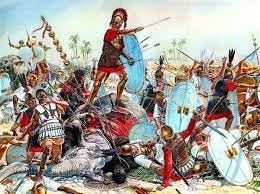If you are looking for the beginning of the study for The Young Carthaginian then you can go HERE for a brief introduction. At the bottom of the introduction you will find the links to each section of the study guide as it becomes available. If you would like to see the growing list of book studies available for free on this site you can go HERE. Enjoy!
Grammar Questions: (The Information of the Text)
According to the text, why was it beneficial that Hannibal had “opened communications with the Gaulish tribes”?
What was the state of Malchus and the company he commanded by the time they finished crossing the Alps?
What was the family like with whom Malchus stayed?
What act of engineering allowed the Carthaginians to breach the walls of Turin?
What was superior about the Carthagenian cavalry compared to the Roman Cavalry at the time?
What humorous thing took place while the Carthaginians were crossing the river Po?
What caused Sempronius to engage Hannibal against Scipio’s counsel?
How long were the battlefronts of the Roman and the Carthagenian armies respectively?
What was said to be “the verdict of great commanders of all ages”?
Logic Questions: (Interpreting, Comparing/Contrasting, Reasoning)
Why do you think Sempronius was beaten by Hannibal despite Rome’s vastly superior forces (at least numerically)?
Why did the slinger’s weaponry change as they got closer to the enemy?
Why did Sempronius write to Rome “saying that he had been victorious” when clearly he had not?
Rhetoric Questions: (The Analysis of Ideas in the Text)
The Roman military seemed to struggle, according to Henty, in part because of its divided military leadership. In your opinion, what would be the best leadership structure for a successful military campaign and why?
Theological Analysis: (Sola Scriptura)
Read Mark 3:22-27. How can Jesus’ wisdom here be applied to our present reading?



